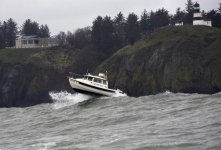C-Wolfe
Member
- Joined
- Sep 16, 2020
- Messages
- 351
- Reaction score
- 0
- Location
- Anchorage
- C Dory Year
- 2008
- C Dory Model
- 255 Tomcat
- Vessel Name
- Valhalla
Marco Flamingo":vl94nift said:Those actual GPH numbers are why I have a 2000 GPH pump with smooth wall hose in my CD 16. I figure that gets me a realistic 600 GPH, about the same rate I could do with a bucket (probably not for an hour). For a serious wave over the stern, GPH likely won't help. I would have to rely on PFD and DSC.
I always said that there is no better bail out pump then a scared sailor with a bucket :lol:

